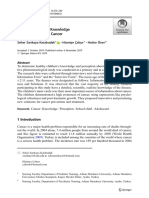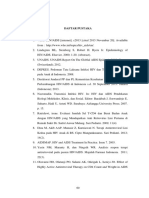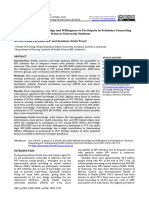Research 2
Research 2
Uploaded by
Princess Faniega SugatonCopyright:
Available Formats
Research 2
Research 2
Uploaded by
Princess Faniega SugatonCopyright
Available Formats
Share this document
Did you find this document useful?
Is this content inappropriate?
Copyright:
Available Formats
Research 2
Research 2
Uploaded by
Princess Faniega SugatonCopyright:
Available Formats
Name of Students: Elea Phoebe Suarez, Princess Sugaton, Alexandra Tolbo, Micah Velez, and
Althea Vertudazo
BSN3F - Group 4B
A. 3 Researchable Nursing Problems (Variables, Hypothesis, and Related Literature)
Common Factors that women diagnosed with Polycystic Ovary Syndrome (PCOS)
ages 12-20 in Bacolod City
Variables:
Independent: Women diagnosed with PCOS
Dependent: Common Factors
Hypothesis: Women who experience such factors are possible to be diagnosed with
PCOS at their adolescence
Rationale: Polycystic Ovary Syndrome is a common disorder prevalent in women of
reproductive age. Having a family history of diabetes mellitus as well as lifestyle are
two common factors of developing a PCOS (Dasai et.al, 2018). The aim of this study
is to find out the common factors affecting the women diagnosed with PCOS and
through this, there would be an early detection. It also aims to make women of
reproductive age aware of the features/factors of PCOS.
Related Literature:
Diamanti-Kandarakis, E., & Dunaif, A. (2012). Insulin Resistance and the Polycystic
Ovary Syndrome Revisited: An Update on Mechanisms and Implications. Endocrine
Reviews, 33(6), 981–1030. https://doi.org/10.1210/er.2011-1034
Lim, A. J., et. al (2016). Sleep Duration, Exercise, Shift Work and Polycystic Ovarian
Syndrome-Related Outcomes in a Healthy Population: A Cross-Sectional Study. PloS
one, 11(11), e0167048. https://doi.org/10.1371/journal.pone.0167048
N. A. Desai, D., R. Y. Tiwari, T., & S. S. Patel, P. (2018). Prevalence of Polycystic
Ovary Syndrome and its Associated Risk Factors among Adolescent and Young Girls
in Ahmedabad Region. Indian Journal of Pharmacy Practice, 11(3), 119–125.
https://doi.org/10.5530/ijopp.11.3.27
Witchel, S. F., Teede, H. J., & Peña, A. S. (2019). Curtailing PCOS. Pediatric
Research, 87(2), 353–361. https://doi.org/10.1038/s41390-019-0615-1
Vidya Bharathi, R., Swetha, S., Neerajaa, J., Varsha Madhavica, J., Janani, D. M.,
Rekha, S., S., R., & B., U. (2017). An epidemiological survey: Effect of predisposing
factors for PCOS in Indian urban and rural population. Middle East Fertility Society
Journal, 22(4), 313–316. https://doi.org/10.1016/j.mefs.2017.05.007
The Level of Acceptance of COVID-19 Vaccines and Vaccination among the
elderly people ages 40 - 70 years old during and after the Pandemic
Variables:
Independent: Vaccine/Vaccination
Dependent: People
Hypothesis: The total percentage of people being apprehensive in getting vaccinated
determines the level of acceptance to vaccines.
Rationale: Hesitancy towards the COVID-19 vaccines poses a huge threat to the
efforts by the government and various organizations in containing and eradicating the
pandemic. (Almalki et al., 2021). Despite the fact that vaccinations have been shown
beneficial in preventing disease, disability, and saving the lives of millions of children,
vaccine hesitancy poses a threat to public health by leading to vaccine delays and
refusals. (Larson et al., 2015). The aim of this study is to determine the level of
hesitance among the people to get vaccinated and to improve the vaccination campaign.
It also aims to aid in better understanding the situation for elderly individuals as well as
health groups and the national government that are working on nationwide vaccination
campaigns.
Related Literature:
Almalki, M. J., Alotaibi, A. A., Alabdali, S. H., Zaalah, A. A., Maghfuri, M. W., Qirati,
N. H., Jandali, Y. M., & Almalki, S. M. (2021). Acceptability of the COVID-19
Vaccine and Its Determinants among University Students in Saudi Arabia: A Cross-
Sectional Study. Vaccines, 9(9), 943. https://doi.org/10.3390/vaccines9090943
Diamanti-Kandarakis, E., & Dunaif, A. (2012). Insulin Resistance and the Polycystic
Ovary Syndrome Revisited: An Update on Mechanisms and Implications. Endocrine
Reviews, 33(6), 981–1030. https://doi.org/10.1210/er.2011-1034
Eilers, R., de Melker, H., Veldwijk, J., & Krabbe, P. (2017). Vaccine preferences and
acceptance of older adults. Vaccine, 35(21), 2823–2830.
https://doi.org/10.1016/j.vaccine.2017.04.014
Larson, H. J., Jarrett, C., Schulz, W. S., Chaudhuri, M., Zhou, Y., Dube, E., Schuster,
M., MacDonald, N. E., & Wilson, R. (2015). Measuring vaccine hesitancy: The
development of a survey tool. Vaccine, 33(34), 4165–4175.
https://doi.org/10.1016/j.vaccine.2015.04.037
Trioano G., et. al. (2021, May). Vaccine hesitancy in the era of COVID-19. Science
Direct . https://www.sciencedirect.com/science/article/pii/S0033350621000834
Correlation between sleep deprivation in nursing students in Bacolod City and
their academic performance
Variables:
Independent: Sleep deprivation
Dependent: Nursing students
Hypothesis: Sleep deprivation in nursing students negatively impacts their academic
performance.
Rationale: Nursing students have a lot going on especially in their academic life. From
lectures to clinical duties, and homeworks to quizzes, sleep is oftentimes jeopardized.
According to a study by Santos et. al (2016), nursing students get little sleep.This study
aims to determine whether or not sleep deprivation is a factor that affects their
academic performance. This would allow us to recommend the ways on how to
manage such correlation.
Related Literature:
Ahrberg, K., Dresler, M., Niedermaier, S., Steiger, A., & Genzel, L. (2012). The
interaction between sleep quality and academic performance. Journal of Psychiatric
Research, 46(12), 1618–1622. https://doi.org/10.1016/j.jpsychires.2012.09.008
Gallego-Gómez, J. I., González-Moro, M. T. R., González-Moro, J. M. R., Vera-
Catalán, T., Balanza, S., Simonelli-Muñoz, A. J., & Rivera-Caravaca, J. M. (2021).
Relationship between sleep habits and academic performance in university Nursing
students. BMC Nursing, 20(1). https://doi.org/10.1186/s12912-021-00635-x
Gallè, F., Sabella, E. A., Roma, P., da Molin, G., Diella, G., Montagna, M. T.,
Ferracuti, S., Liguori, G., Orsi, G. B., & Napoli, C. (2021). Acceptance of COVID-19
Vaccination in the Elderly: A Cross-Sectional Study in Southern Italy. Vaccines, 9(11),
1222. https://doi.org/10.3390/vaccines9111222
Seoane, H. A., Moschetto, L., Orliacq, F., Orliacq, J., Serrano, E., Cazenave, M. I.,
Vigo, D. E., & Perez-Lloret, S. (2020). Sleep disruption in medicine students and its
relationship with impaired academic performance: A systematic review and meta-
analysis. Sleep Medicine Reviews, 53, 101333.
https://doi.org/10.1016/j.smrv.2020.101333
Thomas, C. M., McIntosh, C. E., Lamar, R. A., & Allen, R. L. (2017). Sleep
deprivation in nursing students: The negative impact for quality and safety. Journal of
Nursing Education and Practice, 7(5), 87. https://doi.org/10.5430/jnep.v7n5p87
You might also like
- MODULE 12 Gross Anatomy of The Muscular SystemDocument3 pagesMODULE 12 Gross Anatomy of The Muscular SystemPrincess Faniega Sugaton100% (1)
- ARD Summary SheetsDocument835 pagesARD Summary SheetsGoutham Rajasekaran100% (2)
- WILLS CigaretteDocument15 pagesWILLS CigaretteSachin KapadnisNo ratings yet
- Einstein's Riddle: The SituationDocument4 pagesEinstein's Riddle: The SituationLeong Xin YuNo ratings yet
- New York 501c3 ChecklistDocument6 pagesNew York 501c3 ChecklistFred AbramsonNo ratings yet
- Obstetrics and Gynecology of India Vol.62 (4) :442-445.: Daftar PustakaDocument3 pagesObstetrics and Gynecology of India Vol.62 (4) :442-445.: Daftar PustakayoggihermawanNo ratings yet
- Final EthicalDocument4 pagesFinal Ethicalmbhatti00021No ratings yet
- Medical Students Perceptions Awareness Societal Attitudes and Knowledge of Autism Spectrum Disorder An Exploratory Study in MalaysiaDocument11 pagesMedical Students Perceptions Awareness Societal Attitudes and Knowledge of Autism Spectrum Disorder An Exploratory Study in MalaysiaHobieNo ratings yet
- Synopsis IntroDocument5 pagesSynopsis IntroWallerian DegenrationNo ratings yet
- Health Eduction AssignmentDocument6 pagesHealth Eduction AssignmentHeleina BelayNo ratings yet
- Factors Influencing Contraceptive Uptake Among Lactating Mothers (6-24 Months) - A Case Study of 2medical Reception Station (2MRS)Document7 pagesFactors Influencing Contraceptive Uptake Among Lactating Mothers (6-24 Months) - A Case Study of 2medical Reception Station (2MRS)NanaKarikariMintahNo ratings yet
- Daftar PustakaDocument9 pagesDaftar PustakaIrda OktvNo ratings yet
- R011181725 Skripsi 23-10-2020 (FILEminimizer) Daftar Pustaka Dan Lamp.Document26 pagesR011181725 Skripsi 23-10-2020 (FILEminimizer) Daftar Pustaka Dan Lamp.Marcell KimNo ratings yet
- ReferencesDocument4 pagesReferencesEuh nezNo ratings yet
- Healthy Children's KnowledgeDocument21 pagesHealthy Children's KnowledgeCatarina GrandeNo ratings yet
- Facts and Statistics/breastcancer Facts Andfigures/breast Cancer Facts and Figures 2017 2018 PDFDocument4 pagesFacts and Statistics/breastcancer Facts Andfigures/breast Cancer Facts and Figures 2017 2018 PDFEka PrasetyowatiNo ratings yet
- Primigravida Mothers Knowledge andDocument10 pagesPrimigravida Mothers Knowledge andJamby VivasNo ratings yet
- Afrouz, Maidi Et Al. 2018Document8 pagesAfrouz, Maidi Et Al. 20182013_10_33_03_11_164No ratings yet
- Daftar PustakaDocument4 pagesDaftar PustakashyenismiNo ratings yet
- DafpusDocument4 pagesDafpusdaniah bawazierNo ratings yet
- ICMRDocument4 pagesICMRshalu05edwardNo ratings yet
- Polycystic Ovarian Syndrome PcosDocument15 pagesPolycystic Ovarian Syndrome Pcosapi-341766332No ratings yet
- Risk Factors Affecting Multi-Drug Resistant Tuberculosis in Surakarta and Wonogiri, Central Java, IndonesiaDocument14 pagesRisk Factors Affecting Multi-Drug Resistant Tuberculosis in Surakarta and Wonogiri, Central Java, Indonesiaeis kusmitaNo ratings yet
- 1 s2.0 S0005796711001306 MainDocument6 pages1 s2.0 S0005796711001306 MainMaria CoelhoNo ratings yet
- Global Incidence of Frailty and Prefrailty Among Community-Dwelling Older Adults - PMCDocument25 pagesGlobal Incidence of Frailty and Prefrailty Among Community-Dwelling Older Adults - PMCvarunkrthikvNo ratings yet
- Paper Sik Edo JapungDocument3 pagesPaper Sik Edo Japungedo japungNo ratings yet
- Early Pregnancy Loss in Belagavi Karnataka India 2014-2017 - A PDocument10 pagesEarly Pregnancy Loss in Belagavi Karnataka India 2014-2017 - A PSupreetha Bidar B MNo ratings yet
- Ansong E, Arhin S K, Cai Y, Xu X, Et Al, (2019)Document10 pagesAnsong E, Arhin S K, Cai Y, Xu X, Et Al, (2019)Phong Triệu LêNo ratings yet
- REFERENCESDocument3 pagesREFERENCESVincent OsorioNo ratings yet
- 03 Journal 2010 V9-2Document8 pages03 Journal 2010 V9-2SJ IraaNo ratings yet
- Association Between Nutrient Intake and Female Infertility A Study Based On NHANES DatabaseDocument11 pagesAssociation Between Nutrient Intake and Female Infertility A Study Based On NHANES DatabaseReena SapruNo ratings yet
- Concept PaperDocument3 pagesConcept PaperKharen FlorendoNo ratings yet
- C011171081 - Skripsi DPDocument11 pagesC011171081 - Skripsi DPDinda DeliaNo ratings yet
- Hayleys12877 015 0068 2 PDFDocument12 pagesHayleys12877 015 0068 2 PDFFitria Indah LestariNo ratings yet
- 10 53424-Balikesirsbd 1029908-2104936Document8 pages10 53424-Balikesirsbd 1029908-2104936obenimNo ratings yet
- Henly EDITORIAL JulAug 2016 - Health Communication Research For Nursing ScienceDocument2 pagesHenly EDITORIAL JulAug 2016 - Health Communication Research For Nursing ScienceazminabulsyNo ratings yet
- Daftar PustakaDocument7 pagesDaftar PustakaAdilah RamadhaniNo ratings yet
- Leslie V FarlandDocument10 pagesLeslie V FarlandtiaranindyNo ratings yet
- References DiscussionDocument5 pagesReferences Discussiontapiwa shabanNo ratings yet
- Stress and Depression Among Medical Students - A Cross Sectional Study - Dahlin - 2005 - Medical Education - Wiley Online LibraryDocument39 pagesStress and Depression Among Medical Students - A Cross Sectional Study - Dahlin - 2005 - Medical Education - Wiley Online LibraryMozizAjoguNo ratings yet
- PIIS0015028212002592Document11 pagesPIIS0015028212002592Carolina SidabutarNo ratings yet
- 12q3xsbDocument11 pages12q3xsbShilpa DuttaNo ratings yet
- Prevalence of Sleep Disorders Among University Students and Its Impact On Academic PerformanceDocument4 pagesPrevalence of Sleep Disorders Among University Students and Its Impact On Academic Performancefilmstudio0510No ratings yet
- Cervicitis in Adolescents - Do Clinicians Understand Diagnosis and Treatment?Document6 pagesCervicitis in Adolescents - Do Clinicians Understand Diagnosis and Treatment?brookswalshNo ratings yet
- Daftar PustakaDocument7 pagesDaftar PustakaAnthanasius Claudio SogeNo ratings yet
- Spectrum of Symptoms in Women Diagnosed With Endometriosis During Adolescence Vs AdulthoodDocument11 pagesSpectrum of Symptoms in Women Diagnosed With Endometriosis During Adolescence Vs AdulthoodnicloverNo ratings yet
- Health Belief ModelDocument12 pagesHealth Belief Modelrenzelpacleb123No ratings yet
- A Survey On Knowledge, Awareness, and Perception of Genetic Testing For Hereditary DisordersDocument12 pagesA Survey On Knowledge, Awareness, and Perception of Genetic Testing For Hereditary DisordersMd YousufNo ratings yet
- 2. Pham 2024Document10 pages2. Pham 2024Ima Safitri Puji UtamiNo ratings yet
- PROJECT 4 1Document3 pagesPROJECT 4 1elliebahari.kNo ratings yet
- Arya Ady Nugroho 22010110110095 Bab8KTIDocument27 pagesArya Ady Nugroho 22010110110095 Bab8KTINan WaramoriNo ratings yet
- 2018-Hiv-Aids Related Knowledge and Willingness To Participate in Voluntary Counseling and Testing Among Health Science University StudentsDocument9 pages2018-Hiv-Aids Related Knowledge and Willingness To Participate in Voluntary Counseling and Testing Among Health Science University StudentsSabrina NMNo ratings yet
- Review (Astuti, 2022)Document10 pagesReview (Astuti, 2022)melody tuneNo ratings yet
- Búsqueda ArtículosDocument5 pagesBúsqueda ArtículosElena MorantgNo ratings yet
- Adverse Childhood Experiences and Coping Strategies: Identifying Pathways To Resiliency in AdulthoodDocument17 pagesAdverse Childhood Experiences and Coping Strategies: Identifying Pathways To Resiliency in AdulthoodAndreea PalNo ratings yet
- Daftar PustakaDocument11 pagesDaftar PustakaRizky Dian PratiwiNo ratings yet
- Factors Promoting Resilience Among Breast Cancer PatientsDocument12 pagesFactors Promoting Resilience Among Breast Cancer PatientsffzefanyaNo ratings yet
- Prenatal Factors Associated With The Risk of StuntingDocument3 pagesPrenatal Factors Associated With The Risk of StuntingidafaridaNo ratings yet
- Fertil Ster IlDocument6 pagesFertil Ster IlAstrina SupandyNo ratings yet
- Candy's Chapter TwoDocument24 pagesCandy's Chapter TwoAyodeji AkindeleNo ratings yet
- Prevalence and Risk Factors of Abortion Among Women in Ksa: A Cross - Sectional StudyDocument20 pagesPrevalence and Risk Factors of Abortion Among Women in Ksa: A Cross - Sectional StudyIJAR JOURNALNo ratings yet
- Moderate-to-Severe Diarrhea and Stunting Among ChildrenDocument8 pagesModerate-to-Severe Diarrhea and Stunting Among ChildrenFebry AnaNo ratings yet
- Literature Review 2Document7 pagesLiterature Review 2api-583376290No ratings yet
- Daftar PustakaDocument2 pagesDaftar PustakaCitra YuliasariNo ratings yet
- Social Determinants of Health and Knowledge About Hiv/Aids Transmission Among AdolescentsFrom EverandSocial Determinants of Health and Knowledge About Hiv/Aids Transmission Among AdolescentsNo ratings yet
- Minosa LipidsDocument4 pagesMinosa LipidsPrincess Faniega SugatonNo ratings yet
- Beach Volleyball 2023 Open Tournament Registration FormDocument2 pagesBeach Volleyball 2023 Open Tournament Registration FormPrincess Faniega SugatonNo ratings yet
- 1 s2.0 S089718972030063X MainDocument9 pages1 s2.0 S089718972030063X MainPrincess Faniega SugatonNo ratings yet
- Types of Traction An CareDocument1 pageTypes of Traction An CarePrincess Faniega SugatonNo ratings yet
- Research Revised Results and DiscussionDocument13 pagesResearch Revised Results and DiscussionPrincess Faniega SugatonNo ratings yet
- Casescenario4 CushingsyndromeDocument4 pagesCasescenario4 CushingsyndromePrincess Faniega SugatonNo ratings yet
- PECs Self Rating Questionnaire Profile Form 4Document1 pagePECs Self Rating Questionnaire Profile Form 4Princess Faniega SugatonNo ratings yet
- Assisting in Nasogastric Tube Insertion 1 1Document14 pagesAssisting in Nasogastric Tube Insertion 1 1Princess Faniega SugatonNo ratings yet
- Types of Traction An CareDocument1 pageTypes of Traction An CarePrincess Faniega SugatonNo ratings yet
- HEALTH-TEACHING-PLAN sUGATON EVALDocument9 pagesHEALTH-TEACHING-PLAN sUGATON EVALPrincess Faniega SugatonNo ratings yet
- CHN Long Quiz Rev 1Document8 pagesCHN Long Quiz Rev 1Princess Faniega SugatonNo ratings yet
- The Philippine RevolutionDocument20 pagesThe Philippine RevolutionPrincess Faniega SugatonNo ratings yet
- Case Scenario 3 GerdDocument4 pagesCase Scenario 3 GerdPrincess Faniega SugatonNo ratings yet
- Critic Paper Sugaton BSN3FDocument1 pageCritic Paper Sugaton BSN3FPrincess Faniega SugatonNo ratings yet
- Irs3 Module5 Philipf JDocument2 pagesIrs3 Module5 Philipf JPrincess Faniega SugatonNo ratings yet
- Drug Study Sugaton Week 1 2ND SemDocument3 pagesDrug Study Sugaton Week 1 2ND SemPrincess Faniega SugatonNo ratings yet
- Comlaw Exam EndtermDocument2 pagesComlaw Exam EndtermPrincess Faniega SugatonNo ratings yet
- Tramadol Drug StudyDocument2 pagesTramadol Drug StudyPrincess Faniega SugatonNo ratings yet
- NCP Knowledge DeficitDocument2 pagesNCP Knowledge DeficitPrincess Faniega SugatonNo ratings yet
- Princess NCP COPDDocument3 pagesPrincess NCP COPDPrincess Faniega SugatonNo ratings yet
- Jezamie Capangpangan BSTM 2aDocument2 pagesJezamie Capangpangan BSTM 2aPrincess Faniega SugatonNo ratings yet
- Literature Survey: Product DescriptionDocument6 pagesLiterature Survey: Product DescriptionBryan Rex AnggaNo ratings yet
- Ma de 701Document4 pagesMa de 701echs.203No ratings yet
- Design of Heating ElementDocument3 pagesDesign of Heating ElementSandip MondalNo ratings yet
- SPH3U Exam Review AnsDocument4 pagesSPH3U Exam Review AnsEric Mogilner0% (1)
- Msds HexanaDocument5 pagesMsds HexanaGilang RamadhanNo ratings yet
- Ya ViaDocument6 pagesYa ViahaopengNo ratings yet
- Santi's Project ReportDocument85 pagesSanti's Project ReportdamolaNo ratings yet
- Marcellana BSN2A NCPDocument3 pagesMarcellana BSN2A NCPNicole ObispoNo ratings yet
- Bottom Up Estimation of Resources WeddingDocument2 pagesBottom Up Estimation of Resources Weddingapi-661024335No ratings yet
- Kekuatan Bisnis Dekke Naniura Keunikan Kuliner TraDocument10 pagesKekuatan Bisnis Dekke Naniura Keunikan Kuliner TraFutri PurbaNo ratings yet
- EllapadinDocument13 pagesEllapadinElla PadinNo ratings yet
- Dotson CKD Pharmacy Project 1Document37 pagesDotson CKD Pharmacy Project 1api-748634090No ratings yet
- Repair and Rehab of StructuresDocument5 pagesRepair and Rehab of StructuresSyed Ahmed KabeerNo ratings yet
- Environmental ScienceDocument17 pagesEnvironmental ScienceSilvinus Clisson PragashNo ratings yet
- RoarDocument3 pagesRoarJochieNo ratings yet
- BCPC Annual Work and Financial Plans For Children (Awfpc) 2023Document2 pagesBCPC Annual Work and Financial Plans For Children (Awfpc) 2023Javier HassanNo ratings yet
- Abortion KP RulesDocument26 pagesAbortion KP RulesGSSS udhopur barsalNo ratings yet
- Olga Wells 2014Document2 pagesOlga Wells 2014Eggi Septi Yulianto100% (1)
- KAeserDocument4 pagesKAeserUbanAirlanggaNo ratings yet
- Tagore TheatreDocument30 pagesTagore TheatrehimaniwatalNo ratings yet
- Drawing of Radiator PackageDocument2 pagesDrawing of Radiator PackagevirgilNo ratings yet
- Template Jurnal SemanggiDocument6 pagesTemplate Jurnal SemanggiAnnisa F. MNo ratings yet
- Free PSADocument4 pagesFree PSANIGHT tubeNo ratings yet
- THEOLOGIA Reformata TransylvanicaDocument150 pagesTHEOLOGIA Reformata TransylvanicalegrandinNo ratings yet
- 0610 IECR P3 Q1 v2 PDFDocument9 pages0610 IECR P3 Q1 v2 PDFGAIA Educators - Home TuitionNo ratings yet
- SDS Interthane 990 Signal RedDocument12 pagesSDS Interthane 990 Signal Redonos mondayNo ratings yet















































































































